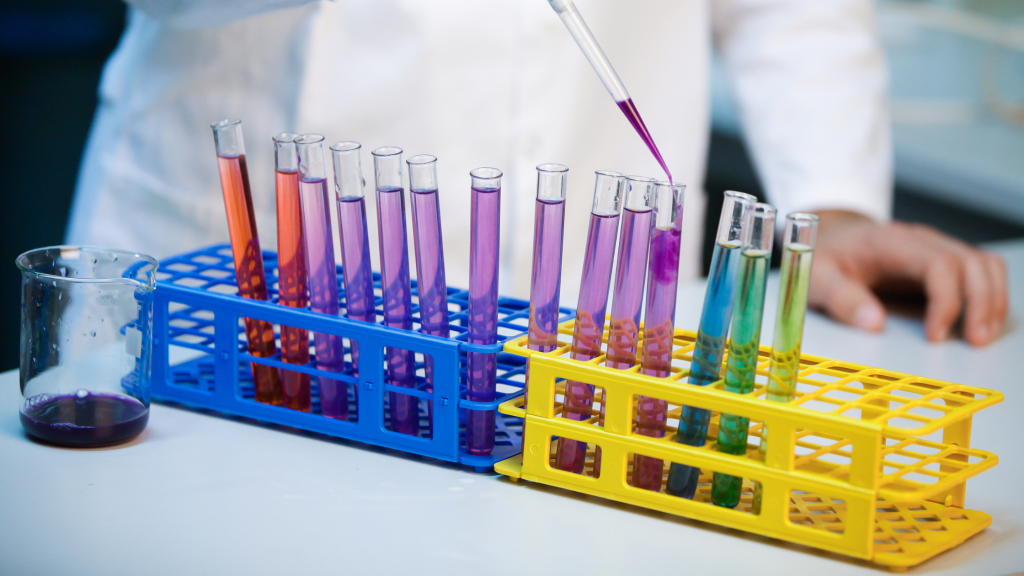Tag Archives: skin science
“Chemistry… if you’re not part of the solution, you’re part of the precipitate.”

My 7th grade chemistry teacher was the first to introduce me to the pH scale by using litmus paper. We could establish the pH value of any liquid by dipping the paper into the liquids and then watching to see what color the paper turned. For example, it would show red for vinegar (acid) and blue for milk (alkaline.) Purple represented a neutral pH. It was fun!
So, what exactly is pH?
The term “pH” refers to “potential of hydrogen”. It concerns the activity of hydrogen ions (ions are molecules that carry a positive or negative charge) in a water-based solution. Hydrogen makes up two thirds of water, water being two hydrogen molecules plus an oxygen molecule, H²o.
The pH of a solution is indicated by a numeric scale that runs from 0–14. Anything below 7 (which is pH neutral) is considered acidic, while anything with a pH greater than 7 is considered alkaline, also referred to as basic.
How does pH relate to our bodies?
In our bodies, blood or cytoplasm are the “solutions” in which the required ions are floating. The normal pH of human blood is 7.35–7.45. Anything above or below that could have negative effects on our health.
With the growing interest in the microbiome in recent years and the ecosystem of our body, the principle of pH balancing is again brought to the forefront. This holistic approach believes that the foundation of healthy digestion is built on a simple eating system that maintains an ideal acid/alkaline (pH) balance in the body. Seventy per cent of the immune system is based in the abdomen and 90% of the tryptophan needed to make serotonin for the brain — essential to ensure we feel good — is made here.
As far as food intake goes, the suggested pH ratio would be a diet of two-thirds alkaline and one-third acid-forming foods. So, to take a step in the right direction, let’s outline a few alkaline foods that we can incorporate in greater quantities and some acidic foods we can eliminate.
Raw, green leafy vegetables like chard, kale and spinach are all excellent alkaline-rich foods. So are avocados, celery, cucumbers, tomatoes, peppers, broccoli, coconut, cherries, grapefruit, lemons and watermelon. A healthy way to start and end each day with an alkaline system for example, would be with a cup of warm water flavored with half a lemon.
Things to avoid would be white flour, coffee, red meat, too much alcohol, simple carbohydrates and artificial sugar.
How does pH affect our skin?
Our skin’s surface and uppermost layers are naturally acidic, making it compatible with acidic skin care products. The skin’s average pH is 4.7 and although the pH of our skin increases with age, it remains acidic.
Our skin has a protective film on its surface that’s known as the acid mantle. It plays a vital role by working with skin-natural ingredients like ceramides, cholesterol, enzymes, sweat, and even our skin’s own oil to protect skin’s surface and lower layers from external threats.
The skin’s acidic pH also plays a role in keeping its delicate microbiome balanced. An acidic microbiome makes it more difficult for harmful pathogens to multiply but lets the good stuff flourish. Frequently disturbing skin’s pH to a strong degree can lead to or worsen many problems, including common skin disorders (eczema, acne, rosacea, and wrinkles) and that dry, tight feeling from washing with bar or liquid soaps (most soaps are alkaline). Using highly acidic (pH 2.5 or lower) or alkaline (pH 8 or greater) products causes a significant disruption in skin’s pH too.
To avoid problems, look for pH-balanced skin care products (between pH 4 and pH 7). How do we do that when skincare products in the US don’t show the product’s pH? An easy solution would be to get a pH test kit available online for home use.
So, getting healthy glowing skin is really easy. All it takes is a few simple and inexpensive tweaks to your beauty routine and your diet.
For more skincare tips, call us at Skinsense Wellness at (323) 653–4701, or check out our other blogs on Medium. And for skincare services, please visit us at 8448 W. Third Street, Los Angeles, CA 90048. We have re-opened our doors and are happy to welcome you all back.



